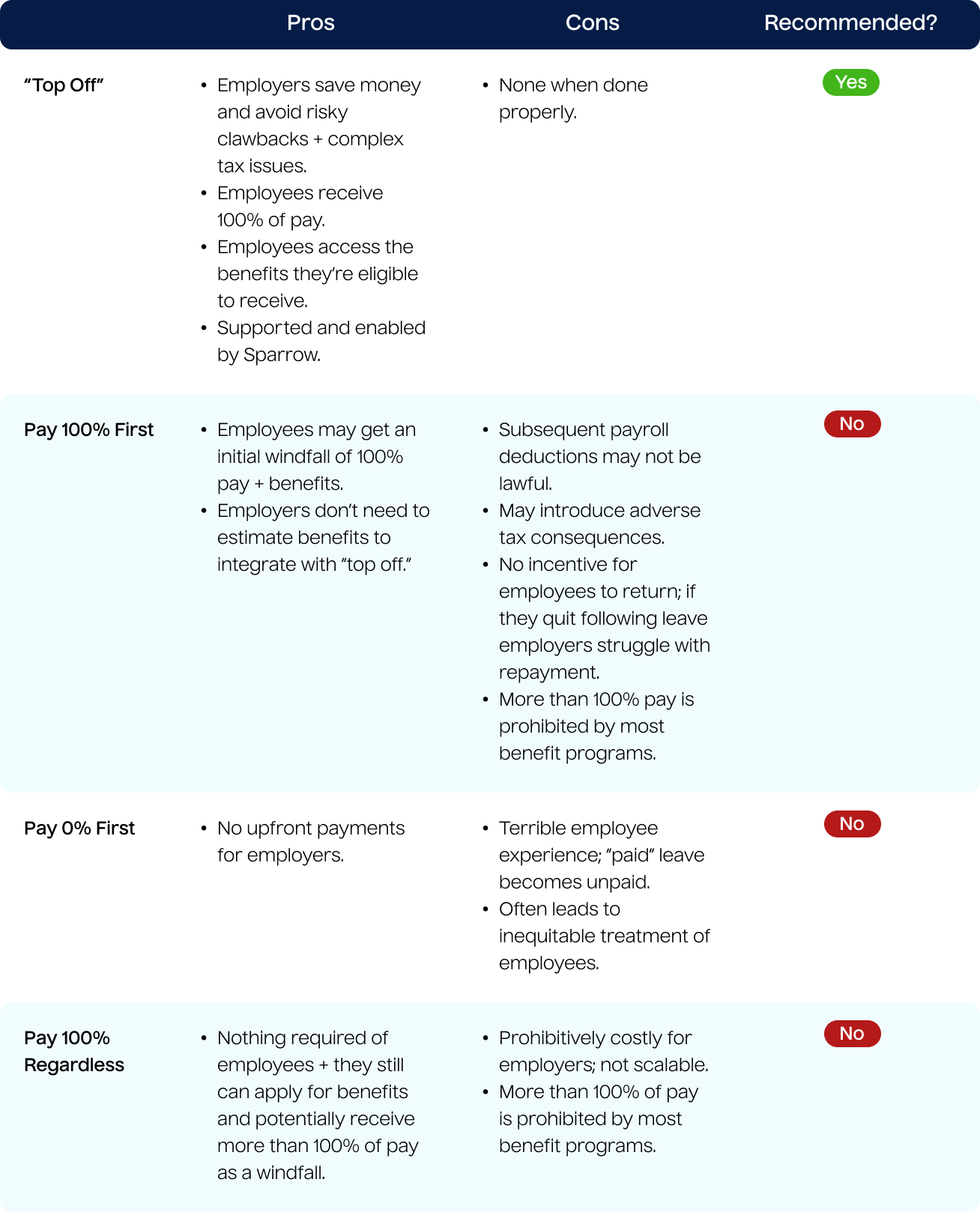

“Salary continuation” is one of the most confusing terms in employee leave. While many people think they understand it, most people use differing definitions. We discuss the pros and cons of some of the most common definitions of salary continuation.
Employers face a range of choices when designing their paid leave of absence policies. Some limit eligibility for paid leave to childbirth and parental bonding. Others extend paid leave to any employees who qualify for a family or medical leave of absence under the federal FMLA or applicable state laws. Then of course there is the amount of paid leave offered. A matter of employer discretion, the total number of paid weeks can vary depending on company size, stage, culture, and industry market sector. Finally, there is how paid leave is structured. While most employers adopt a form of salary continuation, their implementation is not the same. This is where Sparrow occasionally sees employers embrace practices that not only assume risk from a compliance standpoint, but result in excessive costs and expense.
In this post, we take a comprehensive look at salary continuation and address these core questions:
- What is salary continuation?
- What is the recommended best practice for salary continuation?
- How Sparrow can help
- What are the most common mistakes we see in salary continuation?
What is Salary Continuation?
Salary continuation generally is the act of continuing to pay an employee’s base wages during some or all of their leave of absence, consistent with an employer’s paid leave policy, and beyond any waiting period for benefits. Salary continuation does not disqualify employees from receiving partial wage replacement benefits such as disability benefits (state or private disability insurance [SDI/PDI]) or paid family leave (PFL). On the contrary, salary continuation can be integrated with these benefits to “top off” employees and enable them to receive 100% of their base pay while on leave.
Recommended Best Practice: the “Top Off.”
Coordinating salary continuation with available partial wage replacement benefits and using it as a “top off” is the recommended best practice because it supports employees without introducing undue costs and risks to the employer. For this approach to work, the employer must (i) require employees to apply for benefits as a condition of receiving continued pay and (ii) be able to calculate an employee’s expected benefits. This way employers spend less in salary continuation overall (because their employees must access partial wage replacement), and the amounts that are spent don’t result in routine overpayments, which can be legally difficult to claw back.
Sounds pretty simple, right? Not in practice. HR and payroll teams that operate at scale handling multiple leaves in multiple jurisdictions often become overwhelmed.
Here’s Why
Most employers haven’t established effective internal processes for confirming whether an employee has applied for benefits, let alone the amounts received and when. This makes it challenging for internal teams to obtain complete and accurate information for determining correct “top off” amounts. Moreover, claims processes for entitlements, particularly those available from the state, often are complex and difficult for employees to navigate. Mistakes are made. Applications for benefits falter and benefits get delayed - or never even receive approval. The result is expensive. Employee entitlements are left on the table and companies end up paying more than necessary in salary continuation.
How Sparrow Can Help
By managing the claims process from end-to-end and providing automated payroll plans, Sparrow is able to estimate an employee’s entitlement amount and ensure their claim is filed and monitored with employer and employee visibility in an appropriate manner. Sparrow leverages its benefits calculations in its payroll plans, which offer key guidance to payroll teams needing to know how much “top off” in continued salary to include per paycheck. Sparrow’s platform therefore enables employers to adopt salary continuation in a compliant way that saves money without compromising employee experience.
Types of Salary Continuation

How Not to Structure Salary Continuation In-House: What Sparrow has helped fix
Given the inherent challenges with managing salary continuation in-house, some employers have adopted shortcuts that seem convenient on the surface but in reality cause over expenditures meant to be reconciled through risky payroll deductions. Or they cause a terrible employee experience. Or both.
Here are some misplaced strategies Sparrow has worked with employers to un-do, and why:
Start with 100% Pay
Sometimes employers continue paying employees their full salary until any claims are fully paid out, expecting to reclaim overpayments through subsequent payroll deductions or by having employees pay the employer directly. Though well-intended, this approach is not a very positive employee experience on the backend. Employees alternatively contend with smaller paychecks following the return to work or may face complicated adverse tax consequences in a repayment scenario. Moreover, wage deductions fall into a carefully regulated category of wage-hour law. The ability for employers to lawfully deduct from pay varies state-by-state depending on the nature and amount of the deduction and whether advance employee consent has been obtained. Any pattern and practice of wage deduction adopted by an employer should be carefully reviewed by counsel. Finally, not every employee returns to work following a leave. Paying 100% of salary up front risks the employer never receiving reimbursement for any partial wage replacement received - even if the employer has managed to establish a lawful strategy for paycheck deductions. At Sparrow, we’ve witnessed first-hand employers losing tens of thousands of dollars in overpaid, and never reclaimed, salary.
Start with Zero Pay
Alternatively, some employers have a policy of not initiating payments to employees on leave until after their SDI, PDI or PFL benefits have been approved. Because state agency efficiency rates differ and approval times are not uniform, this results in an inequitable experience - even hardship - for employees depending on their location. Sparrow has seen employees in certain states wait months (occasionally up to a year!) for benefit approval through no fault of their own. By then, their leave may be over and they’ve gone completely unpaid without any salary or benefits; it’s not until they’re back at work that they receive weeks’ worth of withheld payments. Meanwhile a different employee in a different state with no state leave benefit program may have been out on a similar leave but paid at 100% from the start of their absence.
Pay 100% Regardless
Other employers don’t expect employees subject to their paid leave policy to apply for SDI or PFL benefits at all. They just continue paying them full wages without any offset against available wage-replacement benefits. Again, this is well-intended because employers assume they’re sparing employees the hassle of applying for benefits. But this practice leaves good money on the table (which, if state-provided, already has been funded by payroll taxes and deductions made by the parties) and is not a viable long-term solution for any enterprise. Particularly when there are organizations like Sparrow who will handle the claims process for the employer on the employee’s behalf. Finally, just because employees are not incentivized to apply for benefits doesn’t mean they won’t do so. Employees can still seek benefits and try to secure payment of more than 100% their normal wages, which could result in allegations of fraud.
Salary continuation can be an effective way to support employees on paid leave, provided it’s done right. Getting it right isn’t always straightforward. Sparrow can help. Outsourcing leave management to Sparrow, with its unique end-to-end claims management system and ability to estimate benefits, enables employers to save money without sacrificing the employee experience.